Background: The rehabilitation of an anterior tooth space presents a confronting situation. Several modalities are presently available to address the challenge of an immediate replacement of a missing anterior tooth. These include a removable temporary acrylic prosthesis or resin-bonded bridges. Fibre-Reinforced Composite (FRC) bridges are preferable if they are fixed and if a cost-effective tooth replacement is desired. Also, they provide an aesthetic and a conservative treatment choice as the abutment teeth require a minimal or no preparation.
Methods: This article is describing two cases with an immediate replacement of the maxillary incisor teeth by a single visit technique, with the use of FRC Resin (Ribbond) bridges and natural tooth crowns as pontics.
Results and Conclusions: The procedure was completed at the chair side, thereby avoiding the laboratory costs. A two year follow up of the cases has shown a successful outcome. Creating an adhesive FRC bridge by using a natural tooth pontic is a successful treatment option for the direct aesthetic replacement of missing anterior teeth.
INTRODUCTION
Loss of anterior tooth may be a catastrophic event for the patient. An immediate replacement is important, to provide a positive psychological approach and to maintain the facial aesthetics and phonetics. Conservation, natural preservation, minimal invasion, aesthetics and cost are some of the important factors that are considered when a missing tooth is replaced [1]. A conventional PFM bridge is the most invasive treatment in terms of the tooth reduction. The resin-bonded Fixed Partial Denture (FPD) is a valid treatment option in selected cases [2,3]. Traditionally, metal alloy has been used as the material for the framework, but Fiber-Reinforced Composite (FRC) is advocated today for their favourable elastic modulus as compared to metals and because of the better adhesion of the composite luting agent to the framework [2,3].
The FRC bridges are adhesive, minimally invasive and economic single unit restorations that can be used for single visit replacement of a missing tooth. A review of the dental literature suggests that the FRC prostheses have good longevity, especially those which are made by the direct technique [4,5]. FRC-FPD can hence act as a substitute to the metal frame resin bonded FPD and also to the full coverage crown retained FPD and the implant supported crowns [4,6,7].
Three forms of pontics can be made for the FRC bridges: with natural extracted teeth, with acrylic resin teeth and by using composite resin. The prefabricated acrylic resin teeth often do not have acceptable colour, size and shape matching and bond unpredictably to composite resin. Although a composite resin pontic may offer good aesthetic results, through the ideal stratification, definite psychological benefits come to the patient by the use of his own natural extracted tooth crown. If the natural tooth is available and if its crown is in good condition, it can be bonded easily to the adjacent teeth by using a light-cured restorative material. Using the natural tooth as a pontic offers the benefits of being the right size, shape and colour, along with producing good aesthetic and functional results [8].
Ribbond is a bondable fibre reinforced material which is made from ultra-high molecular weight polyethylene fibres with a leno-weave orientation. Ribbond has been used for stabilizing traumatized teeth, restoring fractured teeth, for creating a fixed partial denture and for direct-bonded endodontic posts and cores [9,10].
The present paper reports two cases of anterior tooth space rehabilitations which were done by using directly made FRC resin composite (Ribbond) bridges and natural tooth crowns as pontics.
CASE PRESENTATION
Case Report 1
A 38-years-old healthy male patient reported with missing upper left, central incisor. It was inferred from the history that the patient had an extraction 1 month back, because of periodontal reasons [Table/Fig-1]. The patient still carried the tooth with him in water and wanted a single visit treatment.
Missing maxillary central incisor
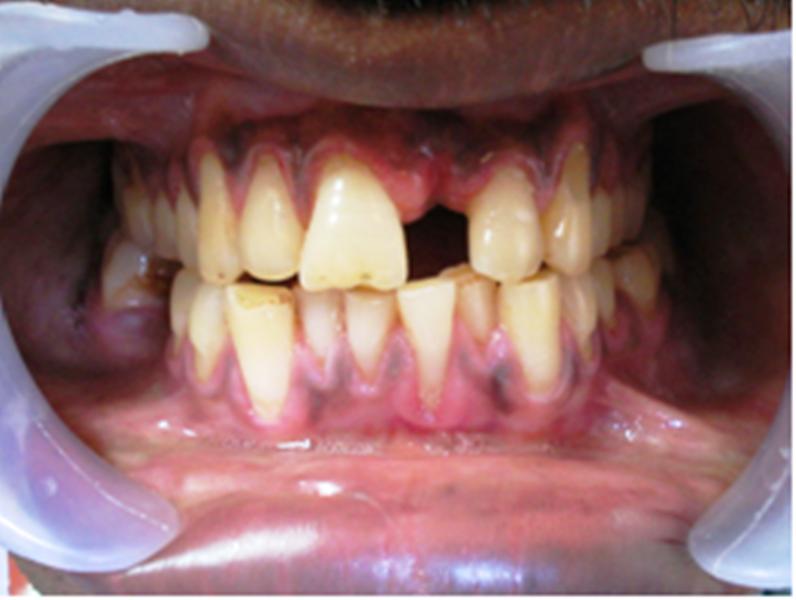
The extracted central incisor was in a reasonably good condition. On clinical examination, the adjacent teeth showed a normal response for vitality. Because the patient was highly concerned with the aesthetics and as he did not want an invasive treatment, it was decided to use the avulsed tooth crown as a natural pontic. An option of a conventional treatment with a crown-retained FPD remained open for the future.
The natural tooth crown was separated from the root by using a diamond disc and it was stored in normal saline solution until it was bonded. The pulp chamber was then cleaned, enlarged slightly and sealed with resin composite [Table/Fig-2]. A modified ridge lap shape was given to the cervical area, to facilitate cleaning and to create an aesthetic emergence profile. Its position was ascertained before bonding, to exclude any occlusal interference.
Natural tooth pontic prepared from the extracted central incisor by root resection and pulp removal
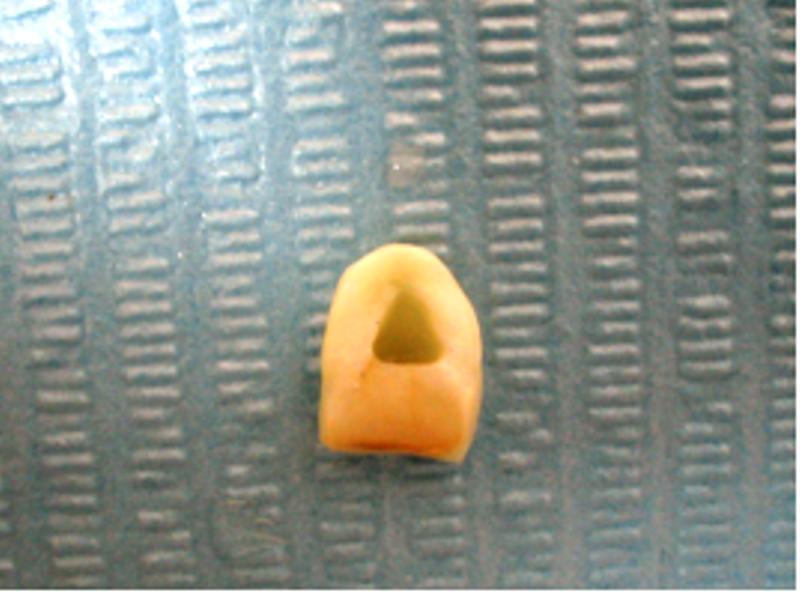
The required length of the Ribbond strip (Ribbond, Inc., Seattle, Washington USA) was predetermined by using a dental floss, by measuring the length from the maxillary left canine to the right lateral incisor. By using the floss as a template, a piece of a 3 mm-wide Ribbond was taken from its package by using cotton pliers and it was cut to an equal length with the Ribbond scissors and placed on a clean surface to prevent contamination [Table/Fig-3].
Ribbond fiber placed palatally
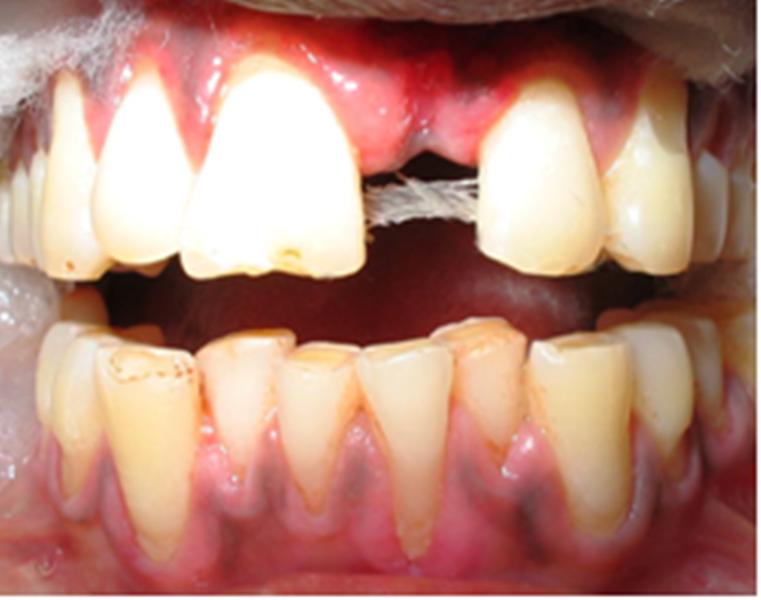
The abutment teeth were roughened by using coarse flame shaped diamond abrasives. They were then isolated, cleaned and dried. The pontic was also cleaned with pumice, washed and dried. The abutment teeth and the pontic were then etched with 35% phosphoric acid (Mission Dental, Tinton Falls, NJ, USA) for 30 secs, washed and dried. Unfilled bonding resin (Adper Single Bond 2, 3M ESPE, St. Paul, MN, USA) was applied to the etched enamel and it was cured. A thin layer of composite resin (flowable composite 3M ESPE, FiltekTMZ350) was placed across the abutment teeth and the pontic.
The pre-cut fibre was thoroughly wetted by using the unfilled resin and it was placed over the composite and cured. A further layer of composite was placed over the tape, ensuring that the whole tape was covered by the composite, and it was cured. The excess composite resin was removed and the occlusal interferences were again checked in the protrusion and the lateral excursions [Table/Fig-4]. The finishing and polishing procedures were carried out by using composite finishing discs and stones (Enhance Composite Finishing and Polishing System DENTSPLY Caulk Dentsply International Inc, Milford, DE). Oral hygiene instructions were given to the patient.
Fiber reinforced resin composite bridge simulates lost natural tooth
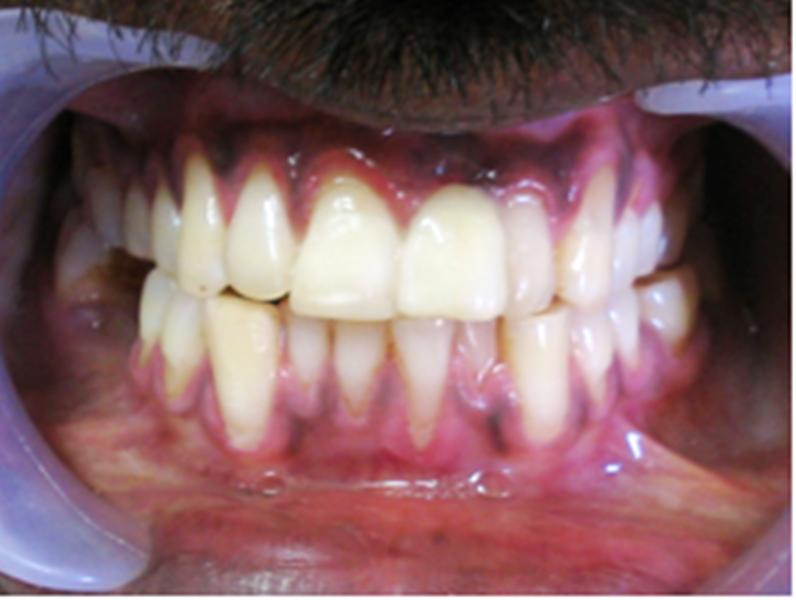
The patient was recalled after a week. The patient was greatly enthused by the final aesthetics and function. The treatment outcome has been monitored over two years and there has been no evidence of problems.
Case Report 2
A 25-years-old female patient was referred for the replacement of the missing upper left lateral incisor that got avulsed as a result of a fall injury, 1 week back [Table/Fig-5]. Her medical history was non-contributory. The patient had brought the tooth along with her, wrapped in a wet towel. The avulsed tooth was in a moderately fine state. The adjacent teeth were checked for vitality, they showed a normal response and there was no associated soft tissue injury. The patient was very particular about the cost of the treatment and the final aesthetics and opted for the economic FRC bridge option with the use of her own avulsed tooth as a pontic. Therefore, it was decided to use the avulsed tooth as a natural pontic for the anterior aesthetic bridge fabrication.
Missing maxillary lateral incisor
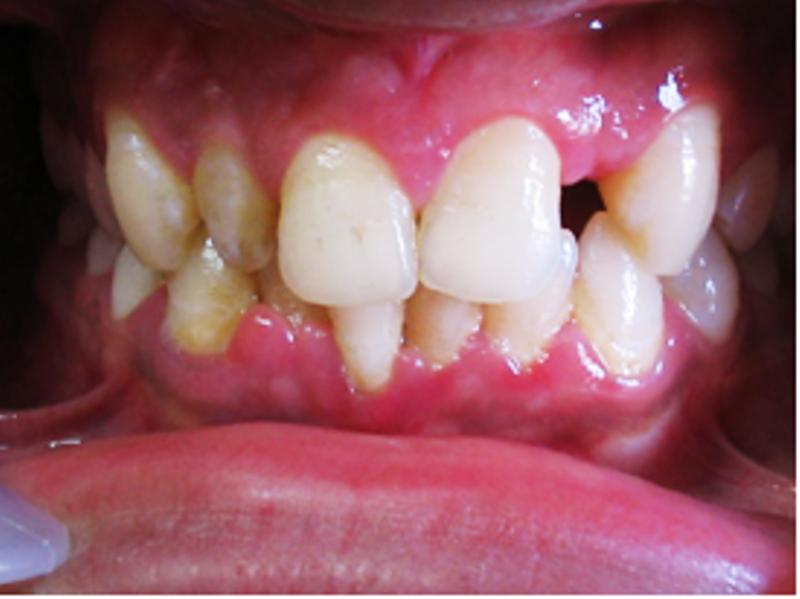
The avulsed tooth was customized by using a similar procedure, as has been discussed for the previous case. The length of the Ribbond strip was measured from the left canine to the left central incisor [Table/Fig-6]. The avulsed tooth pontic was bonded to the adjacent vital teeth by using a premeasured Ribbond FRC strip, as was done in case 1 [Table/Fig-7]. After the bonding procedure, the occlusion was verified in the centric and the eccentric positions, particularly the anterior guidance. The patient was highly satisfied with the results which were obtained [Table/Fig-8]. A two year follow up revealed no functional problems, thus proving the efficacy of the treatment.
Ribbond fiber placed on grooves prepared on palatal surfaces
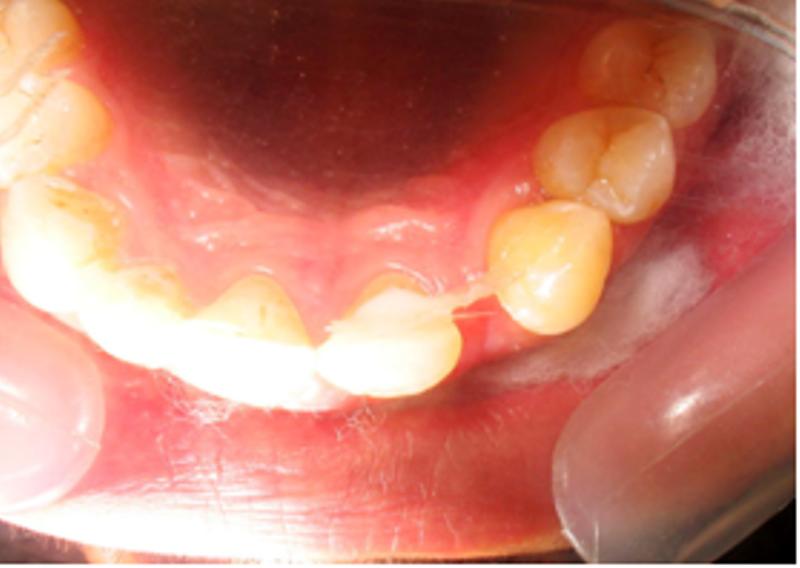
Fiber frame work ready for placement of pontic
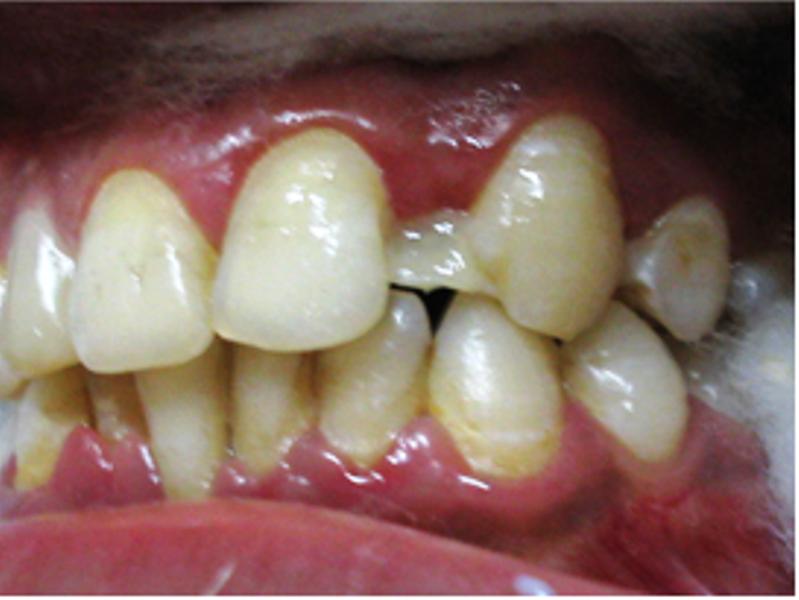
Fiber reinforced resin composite bridge
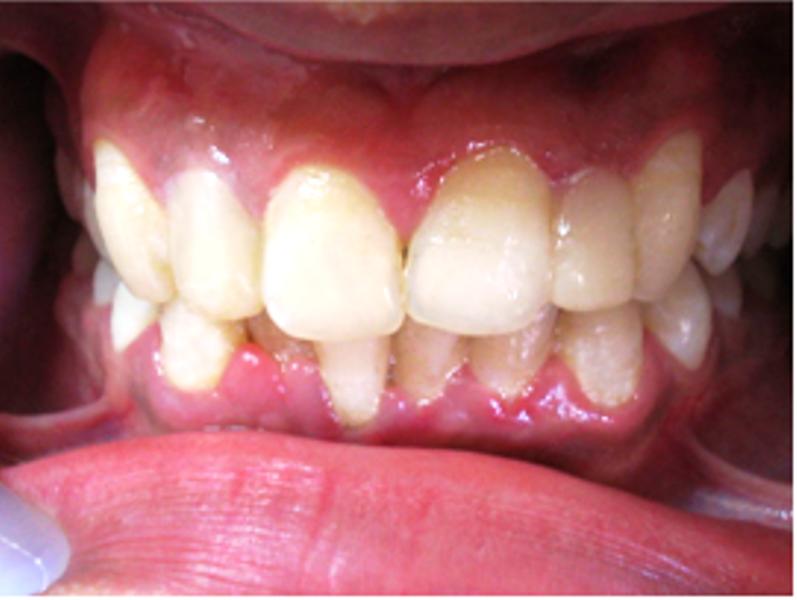
DISCUSSION
The patients with lost anterior teeth require immediate attention for the restoration of the aesthetics and function. A directly fabricated FRC bridge was opted in these cases, in order to provide a single visit, cost effective and a minimally invasive fixed solution to the patient. Clinical studies have shown a substantial clinical performance of the FRC FPDs, with an overall survival rate of 75% after about 5 years, which are higher than that of the FPDs with metal frameworks [11]. The recent laboratory investigations have suggested that the optimally designed FRC FPDs can provide even a higher load-bearing capacity for the FPD than that which the conventional porcelain-fused to metal FPDs can provide [12].
The use of FRC bridges also allows utilization of a patient’s natural crown as a pontic [8], if the tooth or tooth crown is still intact. One major advantage of retaining the patient’s natural crown is that, the patient can better tolerate the effect of the tooth loss [13]. Moreover, it provides the optimal pontic in terms of shape, colour, size and alignment [1].
The Ribbond FRC material which was used in this clinical report was made from ultra-high molecular weight polyethylene fibres which were designed with a lock-stitch feature; so that it effectively transferred forces throughout the weave without stress transfer, back into the resin, thus providing excellent bonding and manageability characteristics. Ribbond provides an increase in the flexural strength and in the flexural modulus of the composite resins, that resist cracking [14].
The natural tooth pontics which were used in this case, provided psychological benefits and a perfect aesthetic match. The pontics were given a modified ridge lap shape having well-polished and smooth convex surfaces [15]. This was done to achieve a mild contact with the alveolar ridge over a very small area, for a better preservation of the soft tissue health [16] and for a better emergence profile from the gingiva. Moreover, the micro-resiliency of the tooth pontic allows stimulation of underlying tissue and it also avoids excessive ridge resorption [1].
With the FRC bridges, the pontic and the abutment teeth require minimal or no preparation. The clinical technique which has been described here is noninvasive and reversible so that all other restorative options can be evaluated at a later date. It offers a simple and cost-effective treatment option for the replacement of a missing anterior tooth, by using its own natural coronal portion. Polyethylene FRC bridges may even be considered as a permanent treatment, due to their strength [17].
However, the limitation of this technique is the availability of intact natural teeth.
Also, the procedure is very much operator-dependent and it requires an appropriate case selection and a precise technique. Though the success in these cases is good, further studies are desired to evaluate the long term success rate of the FRC bridges.
[1]. Parolia A, Shenoy KM, Thomas MS, Mohan M, Use of a natural tooth crown as a pontic following cervical root fracture: a case report Aust Endod J 2010 36:35-38. [Google Scholar]
[2]. van Heumen CC, van Dijken JW, Tanner J, Pikaar R, Lassila LV, Creugers NH, Five year survival of 3-unit fiber-reinforced composite fixed partial dentures in the anterior area Dent Mater 2009 25:820-27. [Google Scholar]
[3]. Heumen van CCM, Kreulen CM, Creugers NHJ, Clinical studies of fiber-reinforced resin-bonded FPDs: systematic review Eur J Oral Sci 2009 117:1-6. [Google Scholar]
[4]. Vallittu PK, Sevelius C, Resin-bonded, glass fiber reinforced composite fixed partial dentures: a clinical study J Prosthet Dent 2000 84:413-18. [Google Scholar]
[5]. Monaco C, Ferrari M, Miceli GP, Scotti R, Clinical evaluation of fiber-reinforced composite inlay FPDs Int J Prosthodont 2003 16:319-25. [Google Scholar]
[6]. Garoushi S, Lassila L, Vallittu PK, Resin-bonded Fiber-Reinforced Composite for direct replacement of missing anterior teeth: A Clinical Report Int J Dent 2011 2011:845420 [Google Scholar]
[7]. Garoushi S, Lassila L, Vallittu PK, Single visit replacement of maxillary canine using Fiber Reinforced Composite resin J Contemp Dent Pract 2012 13:125-29. [Google Scholar]
[8]. Belli S, Ozer F, A simple method for single anterior tooth replacement J Adhes Dent 2000 2:67-70. [Google Scholar]
[9]. Vitale MC, Caprioglio C, Martignone A, Marchesi U, Botticelli AR, Combined technique with polyethlene fibers and composite resins in restoration of traumatized anterior teeth Dent Traumatol 2004 20:172-77. [Google Scholar]
[10]. Strassler HE, Serio CL, Esthetic considerations when splinting with fiber-reinforced composites Dent Clin North Am 2007 51:507-24. [Google Scholar]
[11]. Vallittu PK, Survival rates of resin-bonded, glass fiber-reinforced composite fixed partial dentures with a mean follow-up of 42 months: a pilot study J Prosthet Dent 2004 91:241-46. [Google Scholar]
[12]. Dyer SR, Lassila LV, Vallittu PK, Effect of cross-sectional design on the modulus of elasticity and toughness of fiber-reinforced composite materials J Prosthet Dent 2005 94:219-26. [Google Scholar]
[13]. Ashley M, Holden V, An immediate adhesive bridge using the natural tooth Br Dent J 1998 184:18-20. [Google Scholar]
[14]. Karbhari VM, Strassler H, Effect of fiber architecture on flexural characteristics and fracture of fiber-reinforced composites Dent Mater 2007 23:960-68. [Google Scholar]
[15]. Stein RS, Pontic-residual ridge relationship: A research report J Prosthet Dent 1996 16:251-85. [Google Scholar]
[16]. Edelhoff D, Spiekermann H, Yildirim M, A review of esthetic pontic design options Quint Int 2002 33:736-46. [Google Scholar]
[17]. Chafaie A, Portier R, Anterior fiber reinforced composite resin bridge: a case report Pediatr Dent 2004 26:530-34. [Google Scholar]